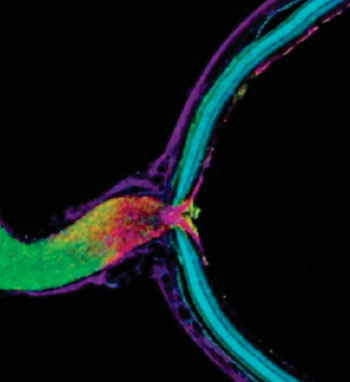Certain Optic Cells Export Their Damaged Mitochondria for Destruction Elsewhere
By LabMedica International staff writers
Posted on 25 Jun 2014
A recent paper revealed that certain cells in the eye transfer damaged mitochondria to neighboring cells for destruction (mitophagy) and recycling.Posted on 25 Jun 2014
Mitophagy is considered a subset of the process known as autophagy, by which damaged organelles are enwrapped and delivered to lysosomes for degradation. As such, it was always assumed that a cell degraded its own mitochondria. However, results presented in the June 16, 2014, online edition of the journal Proceedings of the National Academy of Sciences of the United States of America (PNAS) by investigators at the University of California, San Diego (USA) and Johns Hopkins University (Baltimore, MD, USA) suggest that this assumption may be incorrect.

Image: Pictured is mouse optic nerve and retina, responsible for relaying information from the eye to the brain. The tissue has been fluorescently stained to reveal the distribution of astrocytes (yellow), retinal ganglion cell axons (purple), myelin (green) and nuclei (cyan). Retinal ganglion cell axons transfer mitochondria to adjacent astrocytes in the optic nerve head behind the retina. Astrocytes degrade the mitochondria in a process called transmitophagy (Photo courtesy of the University of California, San Diego).
The investigators used advanced electron microscopy and molecular staining techniques to show that in the optic nerve head, large numbers of mitochondria were shed from neurons to be degraded by the lysosomes of adjoining glial cells. This investigation had been prompted by findings from a glaucoma mouse model that protein products from the retina were accumulating in the optic nerve head just behind the eye.
In the study, a virally introduced tandem fluorophore protein reporter of acidified mitochondria was introduced into mice retinal ganglion cells. The reporter revealed that acidified axonal mitochondria originating from the retinal ganglion cells became associated with lysosomes within columns of astrocytes in the optic nerve head. According to this reporter, a greater proportion of retinal ganglion cell mitochondria were degraded at the optic nerve head than in the ganglions. The investigators coined the term "transmitophagy" to describe this phenomenon.
“It does call into question the conventional assumption that cells necessarily degrade their own organelles. We do not yet know how generalized this process is throughout the brain, but our work suggests it is probably widespread,” said co-senior author Dr. Mark H. Ellisman, professor of neurosciences at the University of California, San Diego. “Mitochondria play prominent roles in the health of axons, which are fundamental to connecting neurons and transmitting information. It should be a priority to further explore what happens in transmitophagy and whether defects in this phenomenon contribute to neuronal dysfunction or disease.”
“The discovery of a standard process for transfer of trash from neuron to glia will most likely be very important to understanding age-related declines in function of the brain and neurodegenerative or metabolic disorders,” said co-senior author Dr. Nicholas Marsh-Armstrong, assistant professor of ophthalmology and neuroscience at Johns Hopkins University. “We expect the impact to be significant in other areas of biomedicine as well.”
Related Links:
University of California, San Diego
Johns Hopkins University













